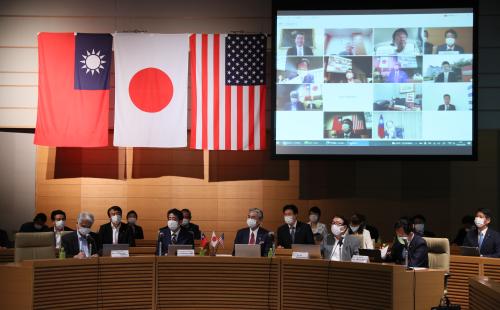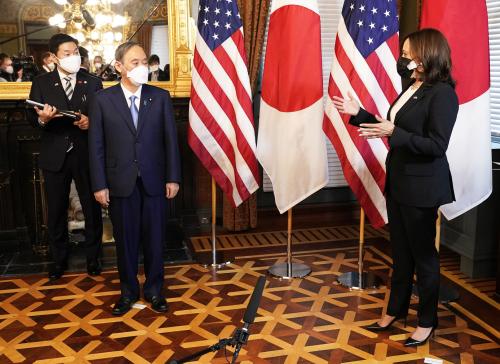Introduction
Japan has no formal role in cross-Taiwan Strait relations.1 But over the past two decades, Tokyo has tweaked domestic security policies and constitutional interpretations, and revised the Guidelines for U.S.-Japan Defense Cooperation twice, which, together, expand the scope of activities that the Japanese Self-Defense Forces (SDF) are theoretically permitted to perform and the geographical areas in which they can operate. While this enhancement in Japan’s defense posture has helped position it to play a greater role in regional security, often overlooked are independent efforts taken by Tokyo to improve ties with Taipei. Japan’s relations with Taiwan are exceptional, but they exist alongside Japan’s complex relationship with the People’s Republic of China (PRC).2 Because of Japan’s “One China” policy, its bilateral ties with Taiwan effectively are a function of its bilateral ties with the PRC. Despite a trend of strengthening ties between Japan and Taiwan, Japan’s relationship with the PRC will continue to dictate how fast and how far any Japanese administration can push bilateral ties with Taiwan.
Strong Japan-Taiwan relations
Japan’s colonization of Taiwan began in 1895. Throughout the early 20th century, Imperial Japan continued a slow expansion until the 1930s, when military leadership took over the reins of power in Tokyo and began to aggressively expand throughout Asia. This drive for empire, and Tokyo’s official control over Taiwan, ended in defeat in 1945. With the signing of the San Francisco Peace Treaty in September 1951 and the Treaty of Peace between Japan and the Republic of China in April 1952, Japan officially gave up all claims to Taiwan. Upon attaining independence from the occupation of the United States in 1952, the Japanese leadership followed the United States in maintaining diplomatic relations with the Republic of China on Taiwan, rather than with the People’s Republic of China in Beijing. Yet Japanese leadership understood that for post-war recovery, trade with mainland China would be indispensable. This, in turn, informed an ambivalent China policy that inclined Tokyo toward a de facto “Two Chinas” policy from the very beginning.
In September 1972, Japan instituted its own version of a “One China” policy and recognized the government of the People’s Republic of China as the sole legal government of China. It established diplomatic relations with Beijing and relegated Japan-Taiwan relations to a nongovernmental, working-level basis. In the Japan-China Joint Communique, Tokyo stated its understanding of the PRC’s stance that Taiwan is an inalienable part of the territory of the PRC, but did not adopt that as its own position.3 Japan’s “One-China” policy places real limits on what Japan can do with Taiwan. For example, it prohibits Japan from sending an ambassador to Taipei. Instead, in 1972 Japan established the Interchange Association to act as Japan’s de facto embassy. For its part, Taiwan created the Association of East Asian Relations.
Even under these conditions, Japan-Taiwan relations have not only been stable, but in recent years, flourished. While trade remains a mainstay of their relationship, including robust two-way flows of capital and technology, people-to-people exchanges continue to thrive. In 2016, roughly 1.9 million Japanese visited Taiwan while approximately 4.17 million residents of Taiwan visited Japan. This positions Taiwan as an important origin of travelers to Japan and destination for Japanese. The number of Taiwan residents coming into Japan ranks third, behind the PRC and South Korea, while Japanese visitors to Taiwan rank fourth, behind the United States, China, and South Korea. An open skies agreement signed in 2011 to liberalize bilateral commercial aviation exchanges has played a significant role in promoting engagement, leading to an increase in flights. These people-to-people ties are fundamental to today’s strong bilateral relations.
Politically, Japanese Prime Minister Shinzo Abe and Taiwan President Tsai Ing-wen have enjoyed close personal ties. While still a presidential candidate, Tsai visited Japan’s Cabinet Office building, which is located right behind Abe’s office. Although nothing was ever confirmed, there was speculation that Tsai and Abe met directly. Shortly after Tsai was elected president in 2016, Abe, as well as Japan’s then-Foreign Minister Fumio Kishida, sent “unprecedented” congratulatory messages for her victory, marking the first time such senior Japanese officials issued such communication to a president-elect of Taiwan. This was reciprocated in October 2017 when Tsai sent a congratulatory note to Abe on his party’s victory in parliamentary elections.
Diplomatically, the two sides have also made significant changes. Bucking the PRC’s efforts to force countries and international organizations to use the term “Chinese Taipei” instead of “Taiwan,” in January 2017 Japan changed the name of its Interchange Association to the Japan-Taiwan Exchange Association to explicitly reflect the organization’s role in Taiwan. Shortly thereafter, Taiwan’s Association of East Asian Relations changed its name to the Taiwan-Japan Relations Association. In March 2017, Japan’s Ministry of Internal Affairs and Communications sent Vice Minister Jiro Akama to Taiwan to attend a tourism promotion event in his official capacity. The visit was significant given that Akama represented the highest-level government representative to officially visit Taiwan since 1972.
Even with issues that touch on security, small but important steps have been taken. In October 2016, the two sides held an inaugural maritime cooperation dialogue that focused on opportunities for collaboration on a wide range of maritime issues such as fisheries, scientific research, and collaboration between their coast guards. At the second meeting in December 2017, they even signed a memorandum of understanding (MOU) on maritime search and rescue operations to allow vessels and rescue staff from either side to help in the event of a maritime emergency near Okinotorishima, an uninhabited atoll housing a research station in the Western Pacific.
These changes signal that Japan and Taiwan can deepen ties within the existing framework of Japan’s “One China” policy. These shifts are possible because, despite Taiwan facing an increasingly narrow diplomatic environment, a broad consensus exists in Tokyo on the importance of strong ties with Taiwan.
In a strategic sense, Japan’s overarching aim is to promote a free and open Indo-Pacific region. In this strategy, Japan places a premium on maintaining the status quo in the international order. Strengthening ties with actors that share common values like democracy and free markets is a means toward that goal. Seen in this light, Taiwan and Japan share common values and a mutual interest in maintaining the status quo and putting pressure on mainland China when it violates the norms and rules underpinning the international order.
In a narrower sense, Japan sees Taiwan as a strategic partner in its long-term battle against China. Over the past decade, the aggressive behavior exhibited by China in the East and South China Seas has pushed Tokyo toward closer strategic partnerships with many countries throughout the Asia-Pacific region. The more prominent are the relationships Japan has nurtured with Australia and India, and to a lesser extent, the Philippines and Vietnam. The same motivation underlying these closer ties is behind Tokyo’s pursuit for warmer relations with Taiwan, as both actors confront a similar security challenge from mainland China.
Managed problems but constrained ties
This does not mean that bilateral Japan-Taiwan ties remain trouble-free. One long-standing issue is the ownership of the Senkaku Islands. While Japan insists that the islands are Japanese territory and maintains administrative control over them, Taiwan claims sovereignty over them, as does the PRC. Calling them the Diaoyutai Islands, falling under the jurisdiction of Yilan County, Taiwan counters Japan’s ownership and argues that its sovereignty over the islands is undisputable based on location, historical evidence, geological composition, and international law. Related, but of lesser gravity, is Taiwan’s dispute of Japan’s claim to a 400,000-square-kilometer exclusive economic zone (EEZ) around Okinotorishima. Rather than claiming sovereignty, Taiwan seeks access to the fishing around the atoll. Another issue stemming from Japan’s imperial expansion is that of “comfort women.” While Japan’s colonization and related historical issues are not as problematic with Taiwan as they are with South Korea or mainland China, Taipei still seeks a formal apology and compensation from Tokyo for the roughly 2,000 women who were identified as comfort women. A lesser known dispute, and shorter in the historical record, stems from Japan’s March 11, 2011 triple disaster. Despite being seven years ago, Taiwan retains a ban on importing food produced in the prefectures exposed to radiation from the Fukushima Daiichi Nuclear Power Plant, much to the consternation of Tokyo.
What is remarkable about these problems is that Japan and Taiwan have been able to set aside these contentious issues and find ways to manage them. The bilateral problems are real, but they never threaten to derail relations. For example, despite being unable to agree on the Senkaku Islands, the two sides concluded almost three decades of negotiations on a civil fishery agreement in April 2013 by excluding the territorial seas around the islands. Under this agreement, the two sides agreed to handle fisheries issues stemming from overlapping EEZs and discuss resource conservation and common fishing rules, and exempted their fishing boats from each other’s law enforcement agencies. Remarkably, Abe remained committed even though local fishermen, particularly those in Okinawa, were not happy about the deal. Similarly, even after Taiwan’s opposition to Japan’s claim to Okinotorishima’s EEZ and Japan detaining a Taiwan fishing vessel in April 2016 that sailed close to the atoll, the two sides were able to reach the 2017 MOU on search and rescue near the atoll. And, although Japan took South Korea to the World Trade Organization (WTO) regarding restrictions Seoul imposed on seafood imports after the 2011 disaster, Japan did not take Taiwan to the WTO regarding Taipei’s food import ban. Instead, Tokyo relied on diplomatic channels and the Japanese Chamber of Commerce and Industry. In January 2018, Taiwan began to show signs that it was open to relaxing the ban.
Despite switching official diplomatic recognition from Taipei to Beijing in 1972, Japan’s fundamental proclivity to maintain a de facto “Two Chinas” policy has not changed. This is because as importantly as Tokyo views Taipei, and has worked to maintain and deepen that relationship, the depth of bilateral ties remains a derivative of Tokyo’s relations with Beijing. Regardless of the consensus in Tokyo regarding the importance of Taipei, there is a stronger consensus throughout the Japanese government on the importance of maintaining peaceful and stable relations with Beijing. China is one of Japan’s largest trade partners, but is also identified as one of Japan’s biggest security challenges and a threat to Japanese sovereignty. While not intending to belittle the importance of Taiwan to Japan, the reality of Japan-PRC ties trumps any argument for Japan pushing faster and further in its relations with Taiwan.
In practice, this has meant that when reaching out to Taipei, Tokyo maintains a constant focus on Beijing’s response. While unspoken, this has given China an indirect role in Japan-Taiwan relations and sets real limitations on how fast and how far Japan’s relationship with Taiwan can progress. But there is an important caveat. Poor relations between Beijing and Tokyo provide Japan with the latitude to seek improved ties with Taipei to hit back on Beijing. In other words, Japan can play a “Taiwan card” against the PRC. It is not a coincidence that most of the improvements in Japan-Taiwan ties since Abe came into office came against a backdrop of spiraling Beijing-Tokyo relations.
Looking ahead
Still, given how much Tokyo considers Beijing in its outreach to Taiwan, how will bilateral ties between Tokyo and Taipei progress? It is safe to say that Japan will seek to maintain relations with Taiwan. But with Tokyo-Beijing ties showing signs of stabilizing, particularly as the two countries prepare to mark the 40th anniversary of their peace and friendship treaty, it is uncertain whether Tokyo will advocate further deepening of ties with Taipei. Should it seek to do so, this will likely be on low-profile projects and largely within existing frameworks. This is because Tokyo will continue to balance its ties with Taipei and Beijing. Looking ahead, three areas are likely to remain predominant in bilateral ties: diplomacy, economics, and non-traditional security issues.
Supporting Taiwan’s efforts to maintain international space: Tokyo recognizes the reality that regional issues are better managed if as many regional actors as possible have a role to play or voice to be heard. Japan understands that Taiwan is in a protracted defensive battle against a narrowing diplomatic space. Currently, Taiwan only has 20 formal diplomatic allies. Within the framework of its “One China” policy, Japan has supported Taiwan diplomatically when it can, both bilaterally and multilaterally. In 2005, Japan exempted residents of Taiwan from having to obtain visas for visits of 90 days or less. And where possible, Japan has supported Taiwan’s inclusion in international organizations and fora, such as becoming a member of Asia-Pacific Economic Cooperation (APEC), an observer in the World Health Organization, and participating in the International Civil Aviation Organization. It is also known that Japanese diplomats talk to other countries in the region to reinforce the importance of Taiwan and the negative impact China has on the regional order. Looking ahead, regardless of the status of Tokyo-Beijing ties, Japan will continue to maintain existing agreements and dialogues with Taiwan, promote its diplomatic presence and importance in international fora, and support President Tsai’s southbound policy emphasizing ties with Southeast and South Asia. It will also continue to support a peaceful resolution to cross-Strait relations.
Maintaining robust economic ties: It is in Japan’s interest to maintain robust bilateral economic ties with Taiwan. In keeping with past steps that sought bilateral improvements within existing frameworks, it is likely that Japan and Taiwan will find a resolution to Taiwan’s food import ban, particularly given the positive signals coming from Taipei regarding this issue. But bilateral ties are likely to be tested by Taipei’s desire to join the Comprehensive and Progressive Agreement for Trans-Pacific Partnership (CPTPP). Taipei has already expressed a strong interest to Japan to take part in the second round of negotiations. Supporting Taiwan in this endeavor will be difficult politically for Tokyo, because such support would raise significant tensions with Beijing who would see Japanese backing of Taiwan as violating its “One China” policy. Still, Japan has an interest in Taiwan’s involvement as this would support Tokyo’s strategy of maintaining a free and open Indo-Pacific and would represent a critical actor in maintaining the rules-based order. While this means Japan could potentially entertain the notion of Taiwan’s involvement in the trade agreement, it is unlikely to openly advocate for it. This will be particularly true should Japan-China relations continue to stabilize.
Continue to support non-traditional security areas: Japan’s westernmost inhabited island of Yonaguni is roughly 70 miles from Taiwan. The Senkaku Islands lie about another 90 miles further north. The proximity means that the surrounding waters are filled with fishing trawlers as well as ships from their respective coast guards. Since the inaugural maritime dialogue in 2016, the two sides have actively discussed maritime-related issues to deconflict any potential friction points between them. At a time when Japan and China have agreed to a crisis management and communication mechanism to avoid sea and air clashes, Tokyo may find the need to create an analogue mechanism with Taipei for risk control at sea. This could easily be pursued through their existing maritime dialogue. Another potential area would be diplomatic or non-military coordination or cooperation on humanitarian assistance and disaster relief (HA/DR) issues. This could involve stockpiling materials or sharing past operational experiences.
What is not likely to happen? Despite the improvement in bilateral ties in recent years, there is little possibility that Tokyo is going to adopt an openly proactive stance on Taiwan. This is not because of disagreements in the Japanese government as to how forward-leaning Tokyo should be with Taipei. Rather, it reflects the consensus of maintaining strong ties with Taipei without destabilizing bilateral ties with Beijing. In practice, this means that the Japanese government will not discuss, let alone hint, at any role Japan would play in Taiwan’s defense. Nor will it advocate selling defensive equipment to Taiwan. It also means that Japan is unlikely to shift its policy of sending retired SDF officers—rather than active ones—to the Japan-Taiwan Exchange Association in Taipei. Similarly, Japan will continue to refrain from any SDF personnel interaction—retired or active—with their counterparts in Taiwan, even in the area of HA/DR. And much to the chagrin of Taiwan, Japan is unlikely to stop scrambling fighter jets to intercept Taiwan aircraft that come near Japanese airspace.
Conclusion
Japan-Taiwan bilateral relations remain strong. This is underpinned by a consensus on both sides on the importance of bilateral ties. Nevertheless, the significance placed on Tokyo-Beijing ties within the Japanese government tend to influence the speed and depth of the Tokyo-Taipei relationship. When relations with the PRC are bad, Japan is willing to do more with Taiwan to irritate China and signal Tokyo’s displeasure with Beijing. This means that as bilateral ties between Beijing and Tokyo continue to stabilize, particularly as the two capitals look to celebrate the 40th anniversary of their peace and friendship treaty, it is likely that Tokyo will have less incentive to deepen ties with Taipei beyond what they are today.
Make no mistake, Japan prioritizes peace and stability in the Taiwan Strait. But, while this view will continue, Japan still maintains no formal role in cross-Strait relations. There is nothing Japan can do to alter that fact, but it does not mean Japan will stop supporting Taiwan in various domains. Despite Japan’s increased attention on its relationship with Taiwan under Abe, Japan’s “One China” policy continues to impose real limits as to how fast and how far any Japanese administration can push bilateral ties while balancing Japan’s relations with the PRC. As long as this remains unchanged, Japan is unlikely to push bilateral ties with Taiwan in new directions or risk upsetting ties with mainland China.
-
Footnotes
- This article was prepared without the participation of RAND. The views expressed do not reflect the views or opinions of RAND.
- Japan’s relationships with both actors also exist alongside U.S.-PRC and U.S.-Taiwan ties, but the impact those ties have on Japan’s relationship with Taiwan are not examined here.
- In its treaty with the Republic of China government in 1952, Tokyo had renounced sovereignty over Taiwan but it did not transfer ownership of the territory to any other state. See “Treaty Of Peace Between The Republic Of China And Japan (Treaty Of Taipei) 1952,” Republic of China and Japan, April 28, 1952, http://china.usc.edu/treaty-peace-between-republic-china-and-japan-treaty-taipei-1952.









Commentary
Op-edStrong but constrained Japan-Taiwan ties
March 13, 2018